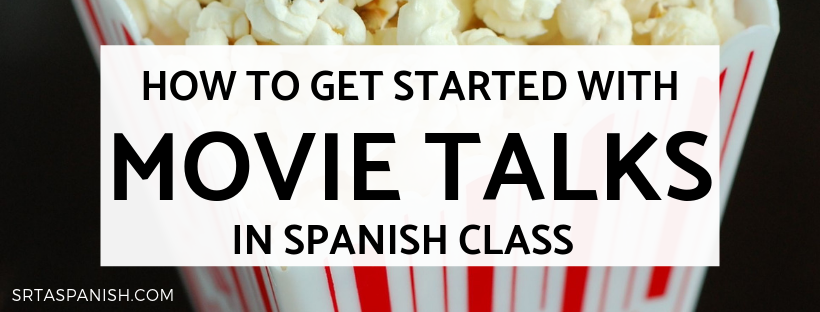
Watch the Video
Background Info:
If you’re not at the stalking stage yet, quick FYI- Movie Talk is a language learning technique developed by Dr. Ashley Hastings. In the most basic sense, you play a short, muted video clip while you describe it in comprehensible language for your students.
The “Stalking Stage”
Now, I’d heard about the technique. CI, circling, TPRS, you name it, I’ve been hovering around the circles and stalking blog posts for years. That doesn’t change the fact that I was super nervous going into doing a movie talk with my kids. So, how does one move from blog stalker to ..movie talker? Here’s some tips!
Getting Started
Central States Conference on the Teaching of Foreign Languages was the kick in the pants I needed to really dig in and plan a Movie Talk. Kristy Placido’s session was particularly helpful to get the wheels turning. Next, I turned to Twitter. #langchat is SO full of resources and support, I hoped they’d help me out!
..and guess what? Amazing resources were shared with me. So, I wanted to compile them, and share them with you!
- MovieTalk Database – This was GOLD. Gold. I had no idea where to start looking. So thankful to Keith Toda (@silvius_toda) for sharing this resource with me. It includes the link, possible language structures/vocab chunks, link to plans if they exist, original language, and other notes from teachers.
- MovieTalk Demo by Martina Bex – There are tons of blog posts out there, but sometimes it’s just nice to see what it can look like in a classroom.
- How to Movie Talk by Allison Wienhold – Sra Wienhold links out to a lot of helpful posts, but what I found most helpful here were her tips on how to prepare students for a Movie Talk. What does it look like when they don’t know what to expect?
- This last tip from Señor Jordan wound up being super helpful to keep in mind while doing the activity with my students! Take your time, ask them questions, build suspense, and natural reactions with the story. Let them interact with the story while you tell it to them!
Movie Talk – Take 1
Using the resources linked above, I prepared for Take 1 of Movie Talk with my students. I honestly felt like I was preparing for a big test, I was so nervous. I found a movie from the database, watched the demo, practiced (alone, in my classroom, gesturing like a crazy person), and then set up the activities to help my students be successful. And you know what? It was great!
I did make a sheet for students I thought would need more help to focus. It’s just a strip of paper that has a word to listen for and asks them to tally whenever they hear it. One kid told me she thought it really helped because she listened to every.single.word. while I was talking. It really helped me between my first class and the last I was able to increase the use of the structures I was trying to target.
My biggest worry was that they would just be sitting and listening, not doing anything during that whole chunk of class which in hindsight kind of feels silly now. Listening in the TL is totally doing something, and requires a lot of focus for them. Add in the story (that I kept pausing every 2 seconds to talk about what was happening) and they were so completely into it. SO into it. A colleague popped into the room during one hour and later she was laughing because she said they were all JUST.STARING. at the screen, at me, and so totally tuned in.

Will there be a sequel?
Absolutely! The responses from my students alone would have decided that. Their “retelling” comics were adorable, and several students expressed verbally that they really enjoyed the activity and would like to do it again! WIN!
I compiled all of the resources I used for the Movie Talk all of my examples in this post are from and added some notes explaining what I did with my students.



So what types of films do you recommend? Can music videos work? Do students end up watching the whole movie at the end? How many minutes is it for? I have 0% knowledge of this! You’ve inspired me to start researching! Is there a ton of stuff made already for free, or is it available on TpT?
Yes to all of the above! I would recommend shorter clips, because you’ll be pausing quite a bit to talk, which lengthens the amount of time you spend. Under 5 min is probably best! You can do it with a music video, or just a corto, because no matter what, the first thing is that you’re watching it without sound, and you as the teacher are narrating what is happening on screen with comprehensible language, focusing on any structures/vocab your students need. Watch that demo I linked from Martina Bex- I found it SUPER helpful to just see what it looks like to do!
This is my first year using TPRS, and I’ve jumped into everything. Circling, movie talks, you name it. I keep thinking back to NTPRS last summer in Reno, when a presenter said, “Your worst day of TPRS is still likely to be ten times better than your best non-TPRS day.”
Yes! That quote totally summed up my feelings after that lesson. Getting all of that input into my students’ brains really helped them, and it went so much more smoothly than I thought it would!
Hi do you do the narrating in the target language and do you teach vocabulary prior to this or is this like a preteach method? Very new to this but very interested in trying!
Hi! I do the narrating in the target language. I will occasionally (rarely) do a mini pre-teach activity, but for the most part I use visual supports! If you go to the link, there’s my free download for a talk that includes the pre activities if you want to see. You may also like my post on Picture Talks! I include some screenshots to show how I set up the screen with the supports that could help you visualize!
https://srtaspanish.com/2018/10/14/picture-talk-101/
Hola,
Thank you so much for this. I’ve dabbled in CI for awhile. I have a couple of questions. 1. Which standards does this (or any movie talk) target? 2. How do you assess?
Hey! I usually tie it into our listening standards in the districts I have worked in – we look for reading, writing, listening, and speaking in our gradebook and listening is the best fit for this activity. I don’t necessarily do a summative assessment, but some good options are doing a quick exit ticket to check for understanding:
https://srtaspanish.com/2019/07/11/exit-ticket-ideas-for-language-class/
or, if we work with it for longer, having them do a timed write or free write to see if they can retell the story at all, or add their own twist (depending on the level):
https://srtaspanish.com/2019/07/15/timed-writing/
I hope that helps!
Kwe’ (hello)!
I need to see a demo of this in English. I see several demos in languages I don’t understand. I teach a First Nation/Native American language. Do you know of a video? Or, would you model one in English the way you would teach it in your target language?
Hi! I can add that to my to do list coming up. I REALLY struggle when I try to demo in English because I speak fast in English on a regular basis so when I try to remember to slow down I often turn out “normal” speed 🤦♀️ I will keep my eyes open for other examples, too!
I do this with EdPuzzles. I didn’t know other people were doing it. I love that students can get comprehensible input this way even if they are absent. https://edpuzzle.com/media/655468d6129bdf4049b80341